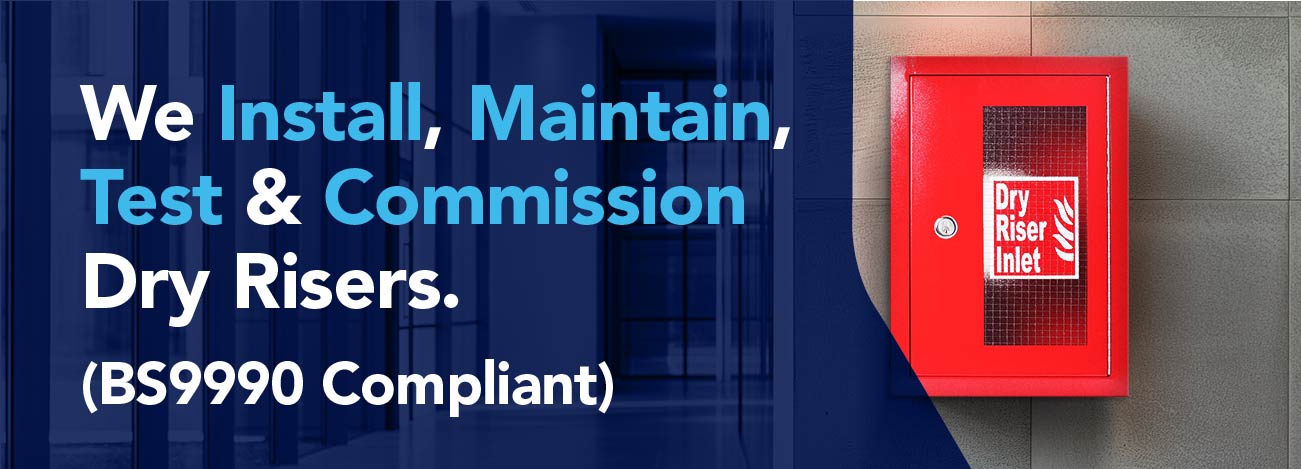29th Jul 2024
What is the Difference Between a Dry Riser and a Wet Riser?What is a Dry Riser and how is it different to a Wet Riser?
Fire safety systems are essential components of any building’s infrastructure, especially in high-rise buildings and large complexes. Among these systems, risers play a crucial role in delivering water to combat fires. There are two primary types of risers: dry risers and wet risers. Understanding the differences between these systems can help in making informed decisions about fire safety. In this blog, we will explore what dry risers are and how they differ from wet risers.
What is a Dry Riser?
A dry riser is a system of pipes installed in a building to facilitate the delivery of water to various floors during a fire emergency. Unlike wet risers, dry risers do not contain water until it is needed. Here are some key features of dry risers:
-
Structure: Dry risers consist of a vertical pipe network with outlets (often called landing valves) on each floor. These outlets allow fire and rescue services to connect hoses and access water at different levels of the building.
-
Installation: The pipes are typically made of materials that can withstand high temperatures, such as galvanised steel. They are installed in a dedicated shaft or within the building’s walls.
-
Operation: In an emergency, fire crews connect the dry riser to a water source, usually a fire engine or hydrant, through an inlet valve located outside the building. Once connected, water is pumped into the dry riser system and made available at each floor’s landing valves.
-
Maintenance: Regular inspection and maintenance are crucial to ensure the system’s reliability. This includes checking for blockages, leaks, and ensuring that the inlet and landing valves are operational.
What is a Wet Riser?
A wet riser is another type of fire protection system, but it operates differently from a dry riser. Here are the main characteristics of wet risers:
-
Structure: Similar to dry risers, wet risers also consist of a network of pipes with outlets on each floor. However, the key difference is that wet risers are constantly filled with water.
-
Installation: Wet risers require a reliable water supply and are connected to a dedicated water tank or a pressurised water source. The pipes used are also designed to withstand high pressures and temperatures.
-
Operation: Since wet risers are always filled with water, they provide immediate access to water during a fire emergency. Firefighters or building occupants can simply connect hoses to the landing valves and begin firefighting efforts without any delay.
-
Maintenance: Wet risers require regular checks to ensure the water supply is uninterrupted and that the system remains pressurised. Inspections also include checking for leaks, pressure tests, and ensuring the integrity of the pipes and valves.
Key Differences Between Dry Risers and Wet Risers
Understanding the differences between dry and wet risers is essential for selecting the appropriate system for a building such as:
-
Water Availability: Dry risers are empty until needed, while wet risers are continuously filled with water. This means wet risers provide immediate water access, whereas dry risers require a connection to an external water source during an emergency.
-
Building Height and Type: Dry risers are typically used in buildings up to 18 meters high, while wet risers are more common in taller buildings where the immediate availability of water is crucial.
-
Maintenance and Testing: Both systems require regular maintenance, but wet risers often involve more rigorous checks due to the constant water pressure and the need to ensure an uninterrupted supply.
-
Cost: Installing and maintaining a wet riser system can be more expensive due to the need for a continuous water supply, additional pumps, and pressure monitoring equipment.
Ultrasafe Fire Suppression Solutions
Both dry and wet risers play critical roles in fire safety, each with its specific applications and advantages. Dry risers are suitable for smaller buildings or those where immediate water supply can be achieved quickly by firefighters. In contrast, wet risers are important for high-rise buildings where the rapid availability of water can make a significant difference in controlling fires.
Choosing the right system depends on the building’s height, design, and fire safety requirements. Here at Ultrasafe we install, maintain and commission dry risers. We can also offer expert advice.
Why do you need Dry Risers?
For optimal functionality and adherence to legal standards, your system must undergo careful design, installation, and regular testing in accordance with British Standards, specifically BS9990:2015, BS9991, BS9999, Further information on standards can be found here. https://knowledge.bsigroup.com/
Get in touch with the Fire Suppression Specialists
Invest in the safety of protecting what matters most. Contact us today for a quote or to learn more about our comprehensive dry riser solutions. Call 01625 467245.
Choosing the right system depends on the building’s height, design, and fire safety requirements. Here at Ultrasafe we install, maintain and commission dry risers. We can also offer expert advice.
Why do you need Dry Risers?
For optimal functionality and adherence to legal standards, your system must undergo careful design, installation, and regular testing in accordance with British Standards, specifically BS9990:2015, BS9991, BS9999, Further information on standards can be found here. https://knowledge.bsigroup.com/
Get in touch with the Fire Suppression Specialists
Invest in the safety of protecting what matters most. Contact us today for a quote or to learn more about our comprehensive dry riser solutions. Call 01625 467245.



